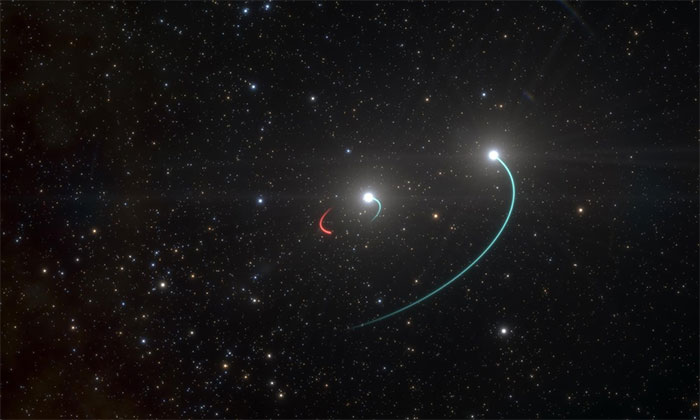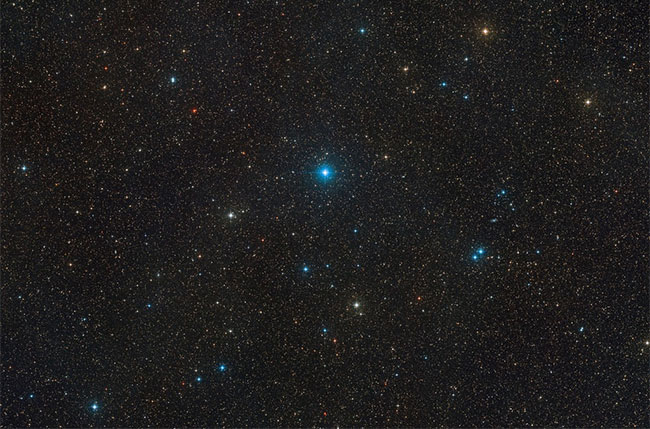Unexpectedly discovered a black hole near the Earth that so far we did not know
In the process of observing and studying the two stars with strange orbiting orbits, astronomers suddenly discovered a black hole close to Earth.
The findings were published May 6 in the journal Astronomy & Astrophysics. The newly discovered black hole lies in the star system HR 6819 , 1,011 light-years from Earth and four times the mass of the Sun.
According to National Geographic, this black hole is about 2,500 light-years closer than the nearest known black hole.

An illustration of a black hole in the star system HR 6819, in which the orbits of the two stars are drawn in blue, while the black hole is colored in red. (Photo: ESO).
Nearly before the eyes without knowing
" It seems to be right there that we don't see it. This is a very bright star system and people have been working on it since the 1980s, but are discovering more and more surprises," said Kareem El-Badry, a graduate student. PhD at the University of California, Berkeley shared.
On a human scale, a thousand light-years is a vast distance, but judging from the galaxy's plan spanning more than 100,000 light-years, the star system HR 6819 is considered to be quite close to Earth , and suggesting that the Milky Way may contain many black holes that people do not know about.

In a telescope image, the star system HR 6819 is centered. The two stars are very close and look like one. (Photo: ESO).
Researchers have long estimated our Milky Way galaxy to be home to hundreds of millions of black holes, extremely dense objects that have strong gravitational forces, even if light cannot escape. out. However, discovering black holes is thought to be extremely difficult.
Some black holes are located near gas regions, thus emitting X-rays when affecting surrounding material. However, most black holes in the galaxy are invisible, so the only way to find them is by observing the gravitational effects of black holes on surrounding objects.
Discovered casually
In the case of the newly discovered black hole, scientists are not actually looking for the black hole but are studying two stars orbiting each other. The outer star, called the Be star , is much larger than the Sun. At the equator, the surface of the star rotates at a speed of about 482,000 meters per second, 200 times faster than the sun's equator.
' It rotates so fast that the contents of the star almost fly by themselves,' said Thomas Rivinius, an astronomer at the Southern European Observatory (ESO) in Chile.
In 2004, observations from the MPG / ESO telescope at La Silla Observatory in Chile showed that besides these stars there could be another object. Five years later, Stan Stefl of the Southern European Observatory offered a review of objects, including a hint of a black hole lurking in HR 6819. But in 2014, Stefl died in a car accident. slightly, causing the work to stop.

The black hole in the LB-1 star system, announced late 2019, paved the way for this new discovery. (Photo: AFP).
In November 2019, Rivinius, Stefl's long-time colleague, saw new evidence to revisit HR 6819. Chinese scientists announced the discovery of a supermassive black hole in the star system. LB-1 belongs to the Milky Way, challenging previous cosmological theories.
Theoretically, a star the size of our Sun could not produce a black hole the size of LB-1. Rivinius's team found that the data of LB-1 was very similar to what they had seen many years ago in the HR 6819 system. After the assumptions were made and excluded, this mysterious third object was studied by researchers. Conclude: a black hole
Scientists led by research co-author Petr Hadrava will analyze the light of HR 6819 and the exact spectra of the two stars, helping to identify their identities. The European Space Agency's Gaia Space Telescope is in the process of mapping the Milky Way with unprecedented precision, potentially providing more details about the orbit of HR 6819.
According to Rivinius, the fruits of this discovery will be a tribute to what Stan Štefl has done. Thanks to the technique of magnetometer, combining multiple telescopes together, it is very likely that in the future the first photos of this supermassive black hole will be revealed.
"Usually when a black hole and a star are nearby, we will not be able to observe the star that orbits the black hole. However, this black hole is very close, so we can observe the movements, and the copper. meaning can measure more precisely its mass , " concluded study co-author Marianne Heida.
- Discover a pair of giant black holes closest to Earth
- The supermassive black hole closest to Earth glows intensely
- Video: Top 5 biggest black holes discovered by NASA in 2017
- Discovering 'super black holes' is 12 times bigger than the Sun.
- Scientists have observed 1000 times the material that the Sun has just emerged from a black hole
- Star 'starving' black hole is a billion light years from Earth
- Black hole detection
- The first time I took a picture of a black hole three million times bigger than Earth
- Find the missing link on the black hole
- The first time a black hole was discovered, it swallowed a star
- What happens when the Earth falls into a black hole?
- Discover the mystery of the most exotic black holes in the universe
- Discovered the unknown type of black hole
- Detecting solar black holes 6 times the diameter of the Earth
 Van Allen's belt and evidence that the Apollo 11 mission to the Moon was myth
Van Allen's belt and evidence that the Apollo 11 mission to the Moon was myth The levels of civilization in the universe (Kardashev scale)
The levels of civilization in the universe (Kardashev scale) Today Mars, the sun and the Earth are aligned
Today Mars, the sun and the Earth are aligned The Amazon owner announced a secret plan to build a space base for thousands of people
The Amazon owner announced a secret plan to build a space base for thousands of people